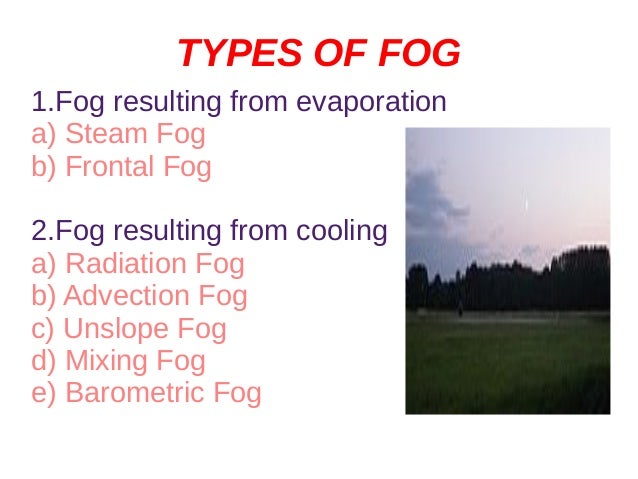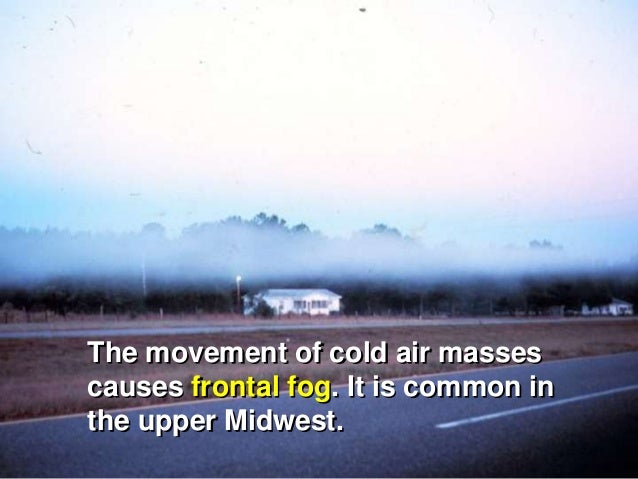
Fog is a
cloud in contact with the ground which reduces visibility to less than 1
km. Fog is formed when water vapour condenses on condensation nuclei
(or particles) in the air near the ground. When conditions are right
these water particles continue to attract more water vapour and grow
until the particles become visible. There are however, several
conditions that initiate the process of fog formation. Fog usually
develops when relative humidity is near 100% and when the air
temperature and dew point temperature are close to one another or less
than 4°F (2.5 °C). As a result, the water vapour condenses to form water
droplets and fog.
Types of Fog:
a) Radiation Fog
 Radiation
fog forms when moist air is cooled below its dew-point by contact with a
cold land surface that is losing heat by radiation.
Radiation
fog forms when moist air is cooled below its dew-point by contact with a
cold land surface that is losing heat by radiation.
The ideal conditions are:
• High relative humidity at low levels so
that overnight cooling will be sufficient for the air temperature to
fall to below its dew point temperature resulting in condensation
occurring.
• Cloudless, or near cloudless skies, to
allow a large heat loss at the ground, and subsequent cooling of the air
in contact with the ground.
• Light winds to promote mixing of this
cooled air through a few hundred feet of the surface (a calm wind tends
to restrict the fog to low-lying pockets).
b) Advection Fog
 Advection
fog develops when warm moist air moves over a cooler surface resulting
in the cooling of the air to below its dew point temperature, and
subsequent saturation and condensation. Radiation processes frequently
assist in the formation and maintenance of this type of fog, but it is
still usually called an advection fog. A certain amount of turbulence is
needed for proper development of advection fog, thus wind between 6-15
knots are commonly associated with advection fog. Notonly
does the turbulence facilitate cooling through a thicker layer, but it
also carries the fog to greater heights. Unlike radiation fogs,
advection fogs are often thick and persistent.
Advection
fog develops when warm moist air moves over a cooler surface resulting
in the cooling of the air to below its dew point temperature, and
subsequent saturation and condensation. Radiation processes frequently
assist in the formation and maintenance of this type of fog, but it is
still usually called an advection fog. A certain amount of turbulence is
needed for proper development of advection fog, thus wind between 6-15
knots are commonly associated with advection fog. Notonly
does the turbulence facilitate cooling through a thicker layer, but it
also carries the fog to greater heights. Unlike radiation fogs,
advection fogs are often thick and persistent.
c) Sea Fog
Sea fogs are usually advection fogs. They
develop when moist air that has been lying over a warm water surface
moves over a colder water surface, resulting in the cooling of this air
to below its dew point temperature.
d) Steam Fog
Steam fog is caused by evaporation from
water into overlying colder air, causes the air to become saturated and
condensation to occur. The convection currents above the water give rise
to the steaming appearance. The fog may remain in situ but any light
wind may advect it many kilometres. This is a common occurrence in areaswhere
large, shallow and warm waterways and dams exist. In coastal areas
where cool land breezes have opportunity to flow across warm seas, steam
fog can be extensive and lift into low stratus.
e) Frontal Fog





Post a Comment
Post a Comment